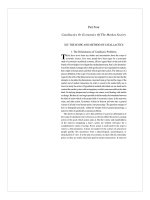micro economics chapter 14 1
Bạn đang xem bản rút gọn của tài liệu. Xem và tải ngay bản đầy đủ của tài liệu tại đây (246.15 KB, 28 trang )
14
Oligopoly and Strategic Behavior
McGraw-Hill/Irwin
Copyright © 2012 by The McGraw-Hill Companies, Inc. All rights reserved.
Oligopoly
• A few large producers
• Homogeneous or differentiated products
• Limited control over price
• Mutual interdependence
• Strategic behavior
• Entry barriers
• Mergers
LO3
Oligopolistic Industries
• Four-firm concentration ratio
• 40% or more to be oligopoly
• Shortcomings
• Localized markets
• Inter-industry competition
• World price
• Dominant firms – Herfindahl Index
LO3
High Concentration Industries
(3)
(1)
(3)
Herfindahl
(1)
4-Firm Concentration Ratio
Index
Industry
Household laundry equipment
100
ND
Household refrigerators and freezers
93
ND
Cigarettes
88
Beer
Industry
(2)
(2)
Herfindahl
4-Firm Concentration Ratio
Index
Primary aluminum
74
2089
Tires
73
1531
2897
Bottled water
71
1564
88
3561
Gasoline pumps
70
1611
Glass containers
86
ND
Bar soaps
70
2250
Phosphate fertilizers
85
3152
Burial caskets
69
1699
Small-arms ammunition
84
2848
Printer toner cartridges
67
1449
Electric light bulbs
84
3395
Alcohol distilleries
65
1394
Aircraf
80
3287
Turbines and generators
61
1263
Breakfast cereals
79
2333
Motor vehicles
60
1178
Aerosol cans
75
1667
Primary copper
50
879
LO1
Oligopoly Behavior
• Game theory
• Profit matrix
– Shows the profits for each firm based on the firm’s actions and his rivals
actions.
• Collusion
– Incentive to cheat
– Prisoner’s dilemma
LO3
Game Theory
RareAir’s price strategy
High
Low
A
B
Uptown’s price strategy
$12
$15
High
$12
C
$6
$6
D
$8
Low
$15
LO1
$8
3 Oligopoly Models
• Kinked Demand Curve
• Collusive Pricing
• Price Leadership
• Reasons for 3 models
• Diversity of oligopolies
• Complications of interdependence
LO5
Kinked Demand Curve
• Criticisms
• Explains inflexibility, not price
• Prices are not that rigid
• Price wars
LO6
Overt Collusion
• Collusion reduces uncertainty, improves control of price, profits
rise, and prevents entry of firms
• Cartels - a group of firms or nations that collude
• Formally written agreement
• Sets output levels and price for members
• OPEC
LO6
Covert Collusion
• Gentleman’s agreements
• Informal understandings often in social settings between firms
about price and output
LO6
Obstacles to Collusion
• Demand and cost differences
• Number of firms
• Cheating
• Recession
• New entrants
• Legal obstacles
• Golden Balls
LO6
Global Perspective
LO6
Price Leadership Model
• Price Leadership
• Dominant firm initiates price changes
• Communicates price change
• Other firms follow the leader
• Use limit pricing to block entry of new firms
• Possible price war
LO6
Positive Effects of Advertising
• Low cost way of providing information to customers
• Enhances competition
• Speeds up technological progress
• Helps firms attain economies of scale
LO7
Negative Effects of Advertising
• Can be manipulative
• Contains misleading claims that confuse consumers
• Consumers may pay high prices for a good while forgoing a
better, lower priced, unadvertised good
LO7
Oligopoly and Efficiency
• Oligopolies are inefficient
• Productively inefficient P > minATC
• Allocatively inefficient P > MC
• Qualifications
• Increased foreign competition
• Limit pricing
• Technological advance
LO7
One-Time Game: Strategy
• One-time game
• Simultaneous game
• Positive sum game
LO7
One-Time Game: Strategy
• One-time game
• Simultaneous game
• Positive sum game
LO7
One-Time Game
Dramco’s price strategy
International
A
B
$5
$11
C
$5
LO7
National
$11
National
Chipco’s price strategy
International
$20
$20
D
$17
$17
A One-Time Game: Equilibrium
• Nash Equilibrium
•
•
•
LO7
Outcome from which neither firm wants to deviate
Current strategy viewed as optimal
Stable and persistent outcome
Credible and Empty Threats
• Credible threats
•
•
•
•
•
Threat is believable
Can be used for collusion
A strong enforcer can prevent cheating
Can generate higher profits
May be countered by rival firm
• Empty threats
•
LO7
Threat is not believable
Repeated Games
• Game recurs
• May cooperate and choose not to compete strongly
• Rival reciprocates
LO7
Repeated Game with Reciprocity
LO7
ThirstQ’s advertising strategy
Promo budget
Normal budget
Promo budget
Normal budget
A
B
A
B
$10
C
$8
$16
$16
D
$12
$12
$11
Promo budget
$8
Normal budget
$10
2Cool’s advertising strategy
Promo budget
Normal budget
2Cool’s advertising strategy
ThirstQ’s advertising strategy
$10
$11
C
$10
$14
$15
D
$13
$13
Sequential Game
• Firms move sequentially
• Final outcome is dependent on who moves first
• First Mover Advantage
•
•
•
LO7
Advantages for the firm that is first
May be better prepared
May preempt entry of rival
First-Mover Advantages
Big Box strategies
Don’t build
Build
A
B
Build
C
$0
LO7
$0
-$5
Don’t build
Huge Box strategies
-$5
$12
$12
D
$0
$0









